Organisational Behaviour Essay: Factors Limiting Perception and Bias
VerifiedAdded on 2022/09/15
|7
|2160
|24
Essay
AI Summary
This essay delves into the complexities of perception biases within organizational behavior. It identifies various factors that distort and limit our ability to accurately gather and interpret information, including personal biases, the halo and horn effects, stereotypes, primacy and recency errors, and self-serving biases. The essay explains how these perceptual errors influence judgment and decision-making. Moreover, it explores strategies individuals and organizations can implement to mitigate the negative impacts of these biases, promoting more objective and effective interactions and outcomes within the workplace. The essay emphasizes the importance of recognizing biases, increasing awareness, and adopting a more comprehensive approach to information processing to foster a fairer and more productive environment.
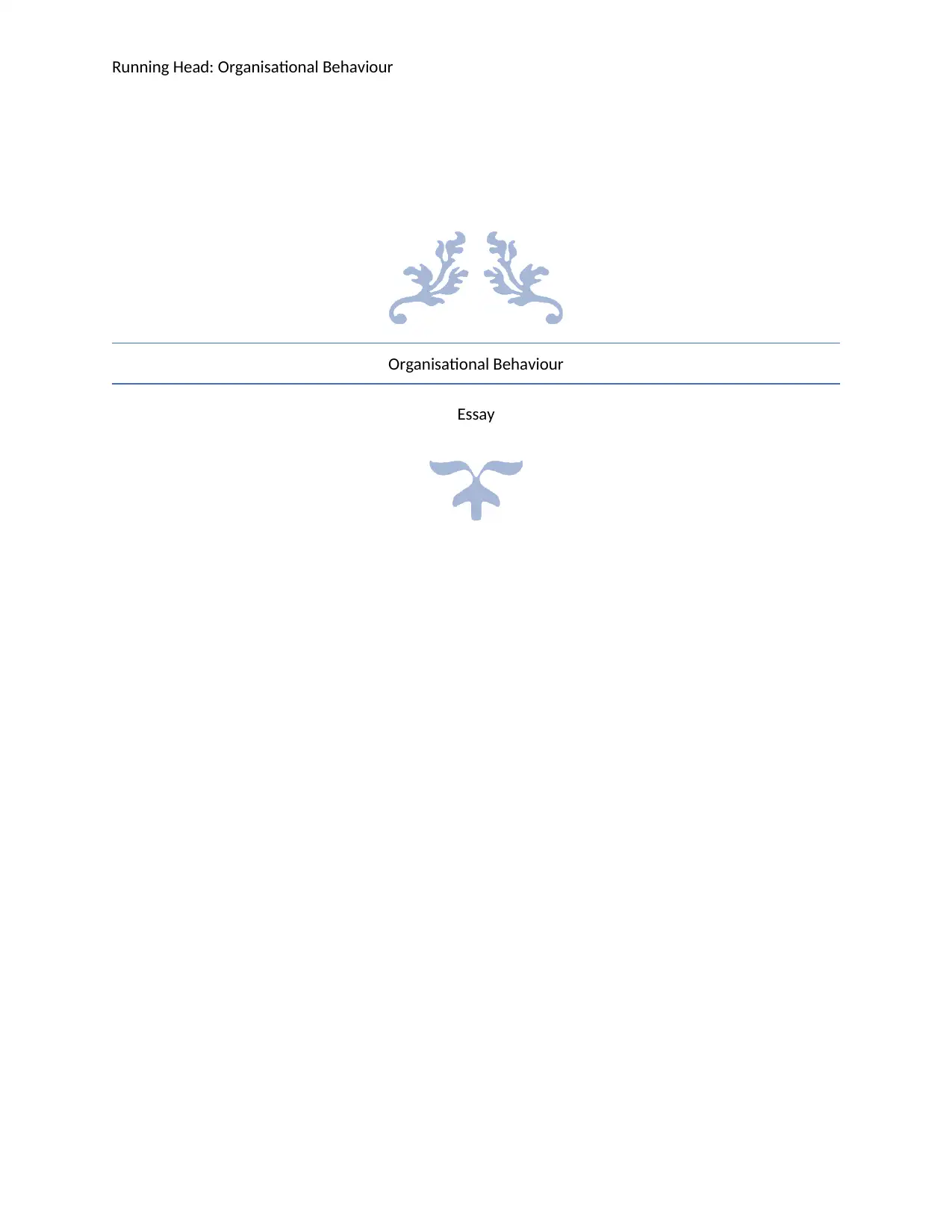
Running Head: Organisational Behaviour
Organisational Behaviour
Essay
Organisational Behaviour
Essay
Paraphrase This Document
Need a fresh take? Get an instant paraphrase of this document with our AI Paraphraser
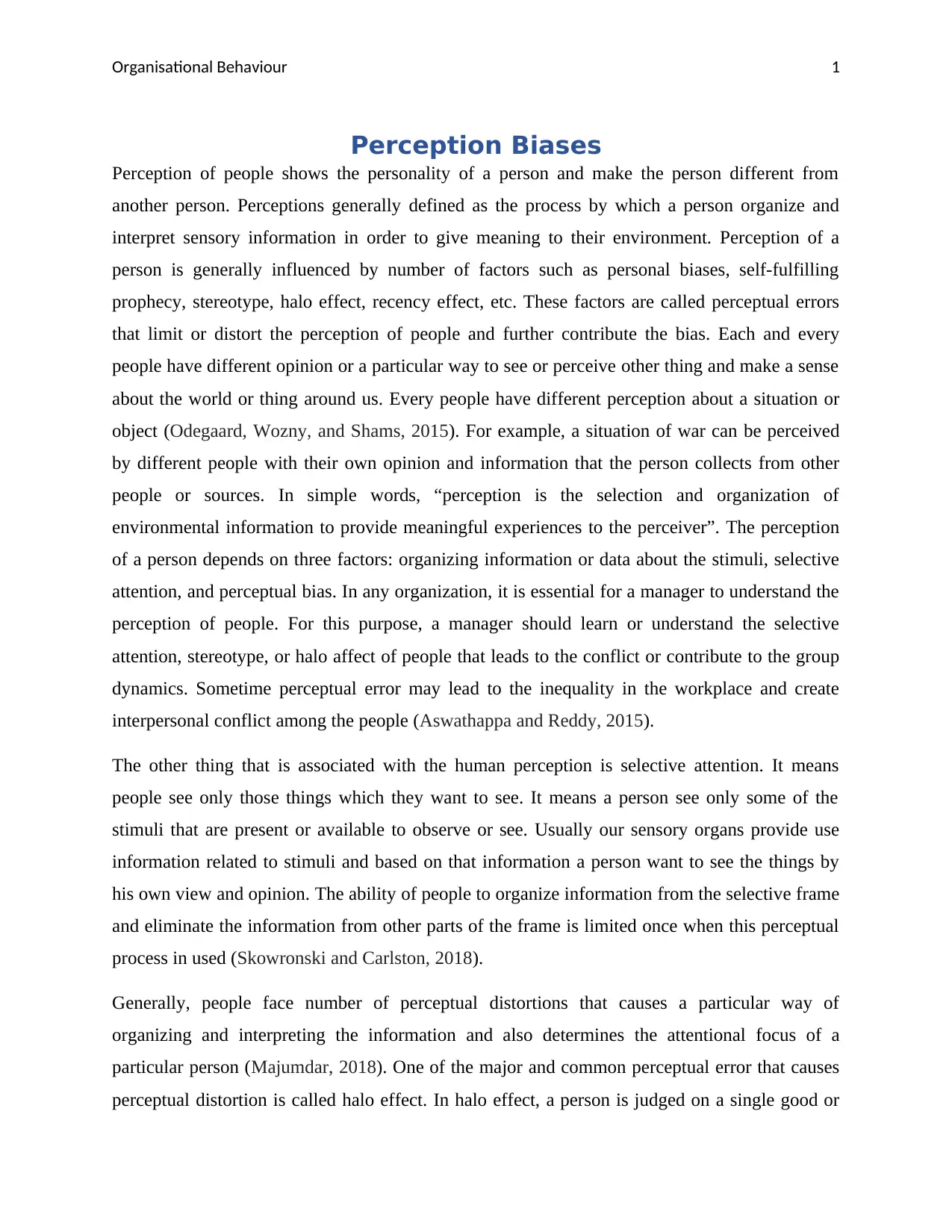
Organisational Behaviour 1
Perception Biases
Perception of people shows the personality of a person and make the person different from
another person. Perceptions generally defined as the process by which a person organize and
interpret sensory information in order to give meaning to their environment. Perception of a
person is generally influenced by number of factors such as personal biases, self-fulfilling
prophecy, stereotype, halo effect, recency effect, etc. These factors are called perceptual errors
that limit or distort the perception of people and further contribute the bias. Each and every
people have different opinion or a particular way to see or perceive other thing and make a sense
about the world or thing around us. Every people have different perception about a situation or
object (Odegaard, Wozny, and Shams, 2015). For example, a situation of war can be perceived
by different people with their own opinion and information that the person collects from other
people or sources. In simple words, “perception is the selection and organization of
environmental information to provide meaningful experiences to the perceiver”. The perception
of a person depends on three factors: organizing information or data about the stimuli, selective
attention, and perceptual bias. In any organization, it is essential for a manager to understand the
perception of people. For this purpose, a manager should learn or understand the selective
attention, stereotype, or halo affect of people that leads to the conflict or contribute to the group
dynamics. Sometime perceptual error may lead to the inequality in the workplace and create
interpersonal conflict among the people (Aswathappa and Reddy, 2015).
The other thing that is associated with the human perception is selective attention. It means
people see only those things which they want to see. It means a person see only some of the
stimuli that are present or available to observe or see. Usually our sensory organs provide use
information related to stimuli and based on that information a person want to see the things by
his own view and opinion. The ability of people to organize information from the selective frame
and eliminate the information from other parts of the frame is limited once when this perceptual
process in used (Skowronski and Carlston, 2018).
Generally, people face number of perceptual distortions that causes a particular way of
organizing and interpreting the information and also determines the attentional focus of a
particular person (Majumdar, 2018). One of the major and common perceptual error that causes
perceptual distortion is called halo effect. In halo effect, a person is judged on a single good or
Perception Biases
Perception of people shows the personality of a person and make the person different from
another person. Perceptions generally defined as the process by which a person organize and
interpret sensory information in order to give meaning to their environment. Perception of a
person is generally influenced by number of factors such as personal biases, self-fulfilling
prophecy, stereotype, halo effect, recency effect, etc. These factors are called perceptual errors
that limit or distort the perception of people and further contribute the bias. Each and every
people have different opinion or a particular way to see or perceive other thing and make a sense
about the world or thing around us. Every people have different perception about a situation or
object (Odegaard, Wozny, and Shams, 2015). For example, a situation of war can be perceived
by different people with their own opinion and information that the person collects from other
people or sources. In simple words, “perception is the selection and organization of
environmental information to provide meaningful experiences to the perceiver”. The perception
of a person depends on three factors: organizing information or data about the stimuli, selective
attention, and perceptual bias. In any organization, it is essential for a manager to understand the
perception of people. For this purpose, a manager should learn or understand the selective
attention, stereotype, or halo affect of people that leads to the conflict or contribute to the group
dynamics. Sometime perceptual error may lead to the inequality in the workplace and create
interpersonal conflict among the people (Aswathappa and Reddy, 2015).
The other thing that is associated with the human perception is selective attention. It means
people see only those things which they want to see. It means a person see only some of the
stimuli that are present or available to observe or see. Usually our sensory organs provide use
information related to stimuli and based on that information a person want to see the things by
his own view and opinion. The ability of people to organize information from the selective frame
and eliminate the information from other parts of the frame is limited once when this perceptual
process in used (Skowronski and Carlston, 2018).
Generally, people face number of perceptual distortions that causes a particular way of
organizing and interpreting the information and also determines the attentional focus of a
particular person (Majumdar, 2018). One of the major and common perceptual error that causes
perceptual distortion is called halo effect. In halo effect, a person is judged on a single good or
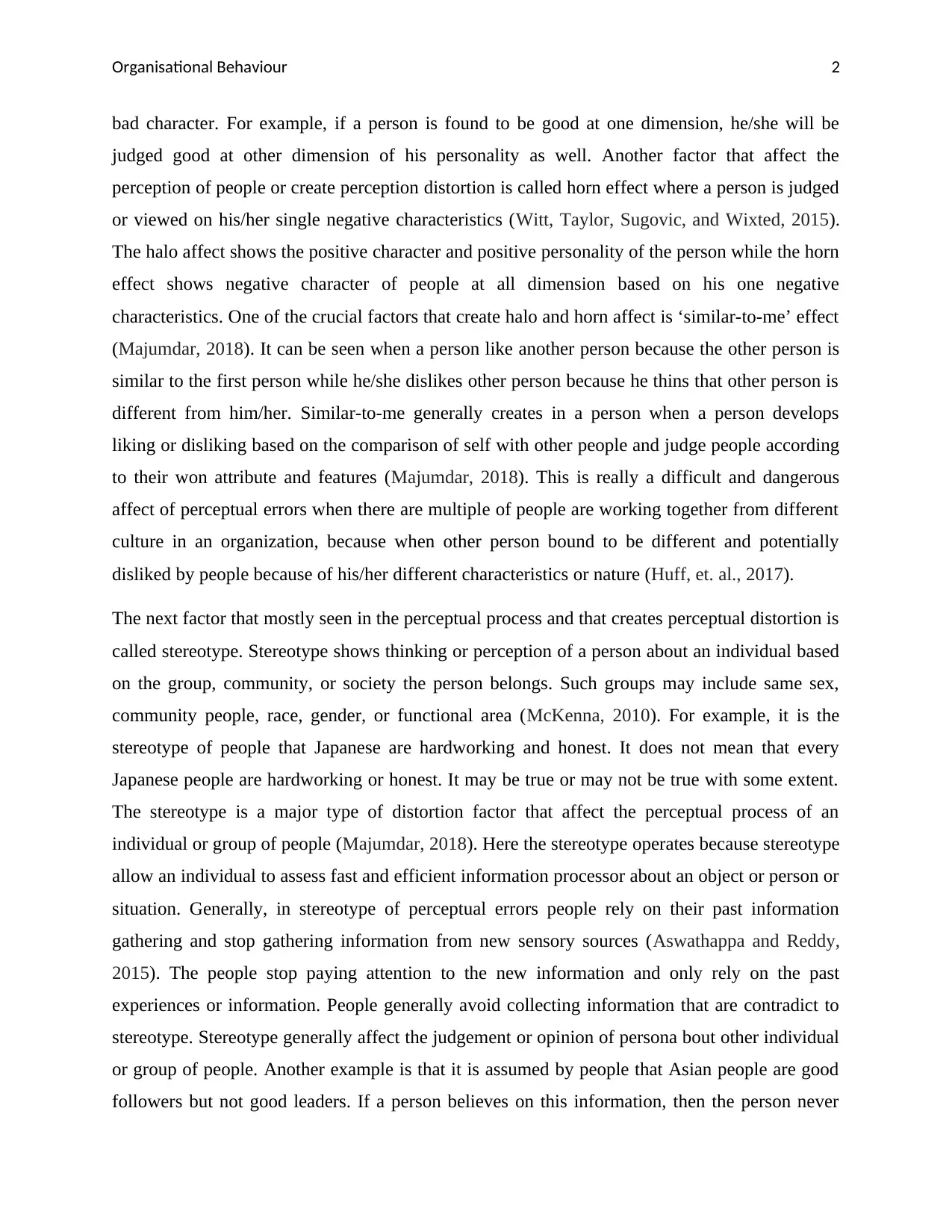
Organisational Behaviour 2
bad character. For example, if a person is found to be good at one dimension, he/she will be
judged good at other dimension of his personality as well. Another factor that affect the
perception of people or create perception distortion is called horn effect where a person is judged
or viewed on his/her single negative characteristics (Witt, Taylor, Sugovic, and Wixted, 2015).
The halo affect shows the positive character and positive personality of the person while the horn
effect shows negative character of people at all dimension based on his one negative
characteristics. One of the crucial factors that create halo and horn affect is ‘similar-to-me’ effect
(Majumdar, 2018). It can be seen when a person like another person because the other person is
similar to the first person while he/she dislikes other person because he thins that other person is
different from him/her. Similar-to-me generally creates in a person when a person develops
liking or disliking based on the comparison of self with other people and judge people according
to their won attribute and features (Majumdar, 2018). This is really a difficult and dangerous
affect of perceptual errors when there are multiple of people are working together from different
culture in an organization, because when other person bound to be different and potentially
disliked by people because of his/her different characteristics or nature (Huff, et. al., 2017).
The next factor that mostly seen in the perceptual process and that creates perceptual distortion is
called stereotype. Stereotype shows thinking or perception of a person about an individual based
on the group, community, or society the person belongs. Such groups may include same sex,
community people, race, gender, or functional area (McKenna, 2010). For example, it is the
stereotype of people that Japanese are hardworking and honest. It does not mean that every
Japanese people are hardworking or honest. It may be true or may not be true with some extent.
The stereotype is a major type of distortion factor that affect the perceptual process of an
individual or group of people (Majumdar, 2018). Here the stereotype operates because stereotype
allow an individual to assess fast and efficient information processor about an object or person or
situation. Generally, in stereotype of perceptual errors people rely on their past information
gathering and stop gathering information from new sensory sources (Aswathappa and Reddy,
2015). The people stop paying attention to the new information and only rely on the past
experiences or information. People generally avoid collecting information that are contradict to
stereotype. Stereotype generally affect the judgement or opinion of persona bout other individual
or group of people. Another example is that it is assumed by people that Asian people are good
followers but not good leaders. If a person believes on this information, then the person never
bad character. For example, if a person is found to be good at one dimension, he/she will be
judged good at other dimension of his personality as well. Another factor that affect the
perception of people or create perception distortion is called horn effect where a person is judged
or viewed on his/her single negative characteristics (Witt, Taylor, Sugovic, and Wixted, 2015).
The halo affect shows the positive character and positive personality of the person while the horn
effect shows negative character of people at all dimension based on his one negative
characteristics. One of the crucial factors that create halo and horn affect is ‘similar-to-me’ effect
(Majumdar, 2018). It can be seen when a person like another person because the other person is
similar to the first person while he/she dislikes other person because he thins that other person is
different from him/her. Similar-to-me generally creates in a person when a person develops
liking or disliking based on the comparison of self with other people and judge people according
to their won attribute and features (Majumdar, 2018). This is really a difficult and dangerous
affect of perceptual errors when there are multiple of people are working together from different
culture in an organization, because when other person bound to be different and potentially
disliked by people because of his/her different characteristics or nature (Huff, et. al., 2017).
The next factor that mostly seen in the perceptual process and that creates perceptual distortion is
called stereotype. Stereotype shows thinking or perception of a person about an individual based
on the group, community, or society the person belongs. Such groups may include same sex,
community people, race, gender, or functional area (McKenna, 2010). For example, it is the
stereotype of people that Japanese are hardworking and honest. It does not mean that every
Japanese people are hardworking or honest. It may be true or may not be true with some extent.
The stereotype is a major type of distortion factor that affect the perceptual process of an
individual or group of people (Majumdar, 2018). Here the stereotype operates because stereotype
allow an individual to assess fast and efficient information processor about an object or person or
situation. Generally, in stereotype of perceptual errors people rely on their past information
gathering and stop gathering information from new sensory sources (Aswathappa and Reddy,
2015). The people stop paying attention to the new information and only rely on the past
experiences or information. People generally avoid collecting information that are contradict to
stereotype. Stereotype generally affect the judgement or opinion of persona bout other individual
or group of people. Another example is that it is assumed by people that Asian people are good
followers but not good leaders. If a person believes on this information, then the person never
⊘ This is a preview!⊘
Do you want full access?
Subscribe today to unlock all pages.

Trusted by 1+ million students worldwide
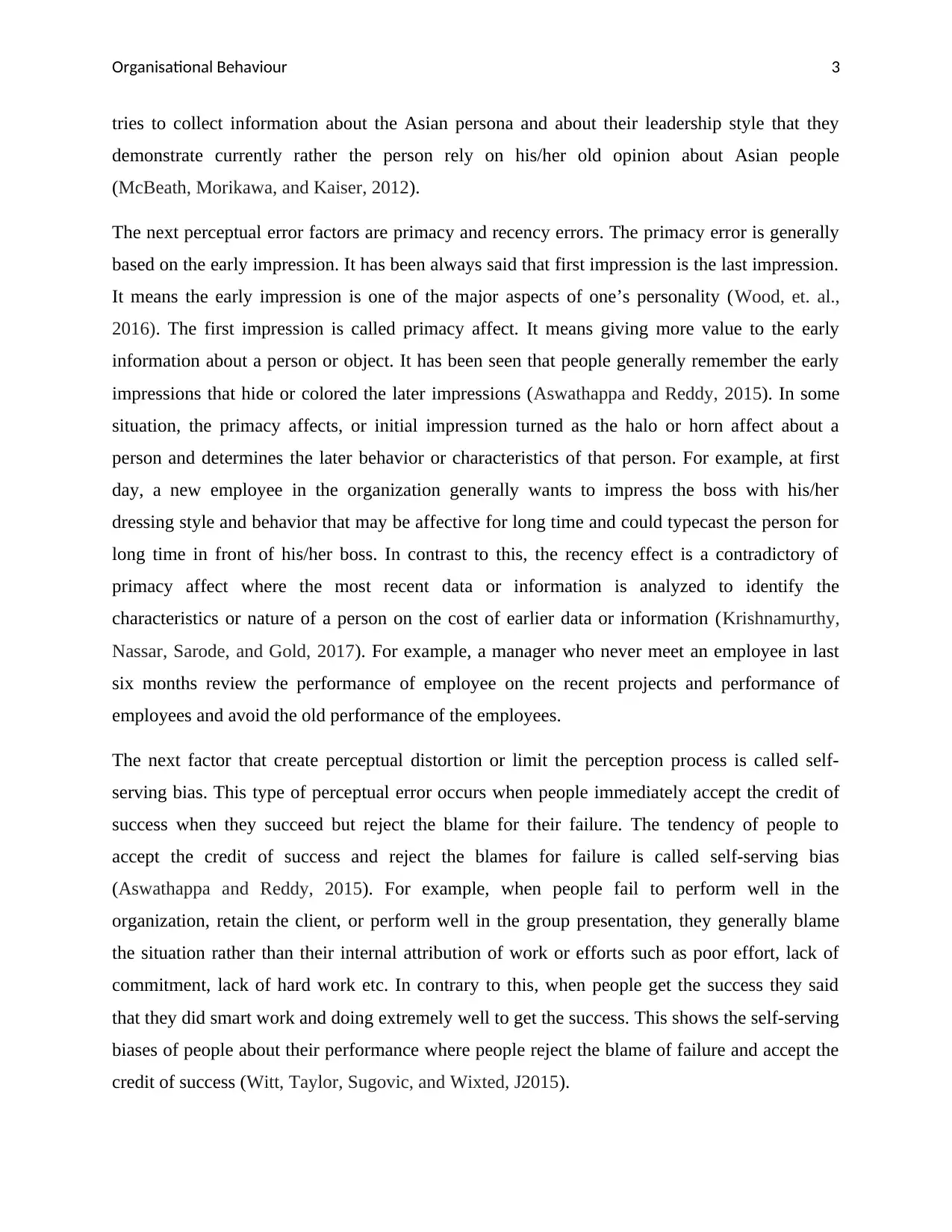
Organisational Behaviour 3
tries to collect information about the Asian persona and about their leadership style that they
demonstrate currently rather the person rely on his/her old opinion about Asian people
(McBeath, Morikawa, and Kaiser, 2012).
The next perceptual error factors are primacy and recency errors. The primacy error is generally
based on the early impression. It has been always said that first impression is the last impression.
It means the early impression is one of the major aspects of one’s personality (Wood, et. al.,
2016). The first impression is called primacy affect. It means giving more value to the early
information about a person or object. It has been seen that people generally remember the early
impressions that hide or colored the later impressions (Aswathappa and Reddy, 2015). In some
situation, the primacy affects, or initial impression turned as the halo or horn affect about a
person and determines the later behavior or characteristics of that person. For example, at first
day, a new employee in the organization generally wants to impress the boss with his/her
dressing style and behavior that may be affective for long time and could typecast the person for
long time in front of his/her boss. In contrast to this, the recency effect is a contradictory of
primacy affect where the most recent data or information is analyzed to identify the
characteristics or nature of a person on the cost of earlier data or information (Krishnamurthy,
Nassar, Sarode, and Gold, 2017). For example, a manager who never meet an employee in last
six months review the performance of employee on the recent projects and performance of
employees and avoid the old performance of the employees.
The next factor that create perceptual distortion or limit the perception process is called self-
serving bias. This type of perceptual error occurs when people immediately accept the credit of
success when they succeed but reject the blame for their failure. The tendency of people to
accept the credit of success and reject the blames for failure is called self-serving bias
(Aswathappa and Reddy, 2015). For example, when people fail to perform well in the
organization, retain the client, or perform well in the group presentation, they generally blame
the situation rather than their internal attribution of work or efforts such as poor effort, lack of
commitment, lack of hard work etc. In contrary to this, when people get the success they said
that they did smart work and doing extremely well to get the success. This shows the self-serving
biases of people about their performance where people reject the blame of failure and accept the
credit of success (Witt, Taylor, Sugovic, and Wixted, J2015).
tries to collect information about the Asian persona and about their leadership style that they
demonstrate currently rather the person rely on his/her old opinion about Asian people
(McBeath, Morikawa, and Kaiser, 2012).
The next perceptual error factors are primacy and recency errors. The primacy error is generally
based on the early impression. It has been always said that first impression is the last impression.
It means the early impression is one of the major aspects of one’s personality (Wood, et. al.,
2016). The first impression is called primacy affect. It means giving more value to the early
information about a person or object. It has been seen that people generally remember the early
impressions that hide or colored the later impressions (Aswathappa and Reddy, 2015). In some
situation, the primacy affects, or initial impression turned as the halo or horn affect about a
person and determines the later behavior or characteristics of that person. For example, at first
day, a new employee in the organization generally wants to impress the boss with his/her
dressing style and behavior that may be affective for long time and could typecast the person for
long time in front of his/her boss. In contrast to this, the recency effect is a contradictory of
primacy affect where the most recent data or information is analyzed to identify the
characteristics or nature of a person on the cost of earlier data or information (Krishnamurthy,
Nassar, Sarode, and Gold, 2017). For example, a manager who never meet an employee in last
six months review the performance of employee on the recent projects and performance of
employees and avoid the old performance of the employees.
The next factor that create perceptual distortion or limit the perception process is called self-
serving bias. This type of perceptual error occurs when people immediately accept the credit of
success when they succeed but reject the blame for their failure. The tendency of people to
accept the credit of success and reject the blames for failure is called self-serving bias
(Aswathappa and Reddy, 2015). For example, when people fail to perform well in the
organization, retain the client, or perform well in the group presentation, they generally blame
the situation rather than their internal attribution of work or efforts such as poor effort, lack of
commitment, lack of hard work etc. In contrary to this, when people get the success they said
that they did smart work and doing extremely well to get the success. This shows the self-serving
biases of people about their performance where people reject the blame of failure and accept the
credit of success (Witt, Taylor, Sugovic, and Wixted, J2015).
Paraphrase This Document
Need a fresh take? Get an instant paraphrase of this document with our AI Paraphraser
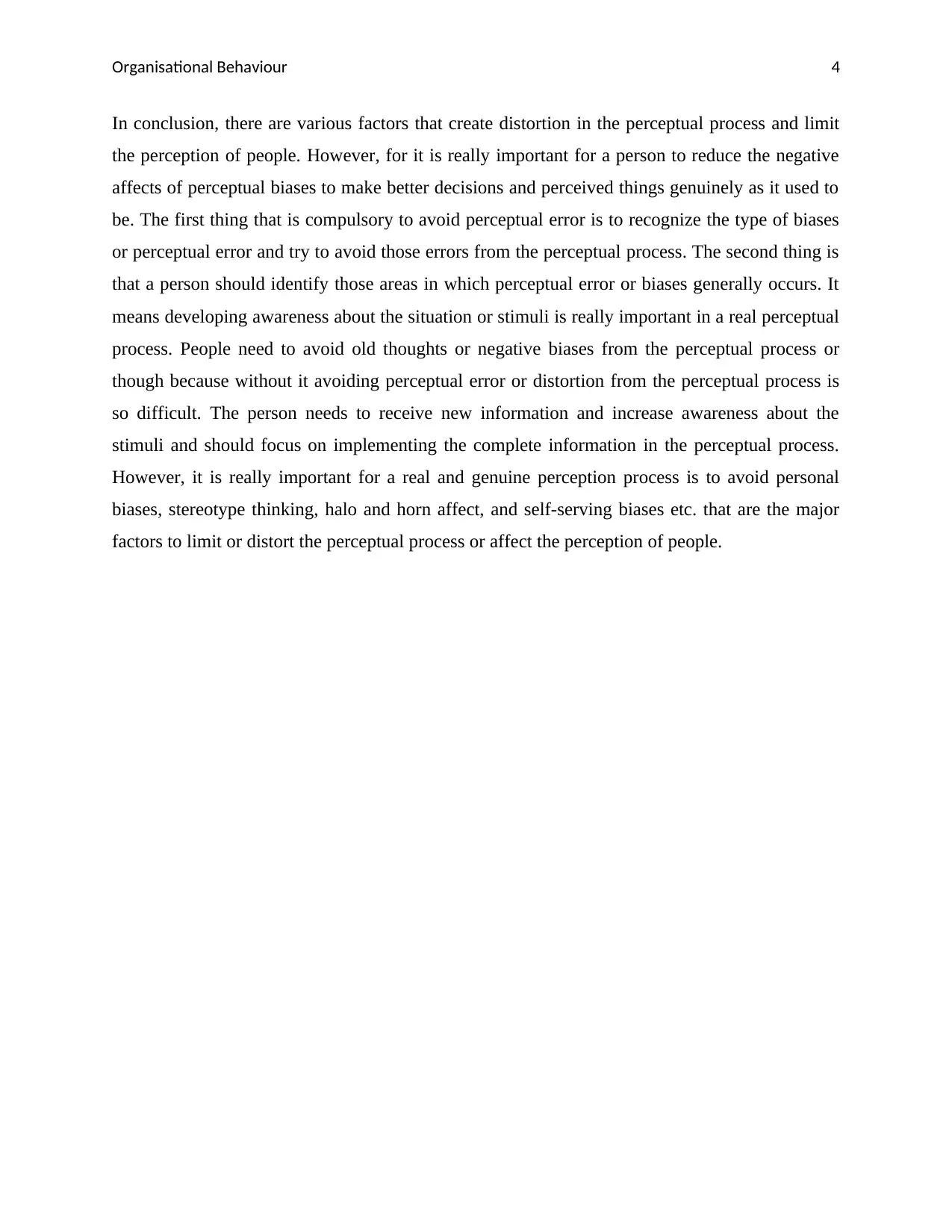
Organisational Behaviour 4
In conclusion, there are various factors that create distortion in the perceptual process and limit
the perception of people. However, for it is really important for a person to reduce the negative
affects of perceptual biases to make better decisions and perceived things genuinely as it used to
be. The first thing that is compulsory to avoid perceptual error is to recognize the type of biases
or perceptual error and try to avoid those errors from the perceptual process. The second thing is
that a person should identify those areas in which perceptual error or biases generally occurs. It
means developing awareness about the situation or stimuli is really important in a real perceptual
process. People need to avoid old thoughts or negative biases from the perceptual process or
though because without it avoiding perceptual error or distortion from the perceptual process is
so difficult. The person needs to receive new information and increase awareness about the
stimuli and should focus on implementing the complete information in the perceptual process.
However, it is really important for a real and genuine perception process is to avoid personal
biases, stereotype thinking, halo and horn affect, and self-serving biases etc. that are the major
factors to limit or distort the perceptual process or affect the perception of people.
In conclusion, there are various factors that create distortion in the perceptual process and limit
the perception of people. However, for it is really important for a person to reduce the negative
affects of perceptual biases to make better decisions and perceived things genuinely as it used to
be. The first thing that is compulsory to avoid perceptual error is to recognize the type of biases
or perceptual error and try to avoid those errors from the perceptual process. The second thing is
that a person should identify those areas in which perceptual error or biases generally occurs. It
means developing awareness about the situation or stimuli is really important in a real perceptual
process. People need to avoid old thoughts or negative biases from the perceptual process or
though because without it avoiding perceptual error or distortion from the perceptual process is
so difficult. The person needs to receive new information and increase awareness about the
stimuli and should focus on implementing the complete information in the perceptual process.
However, it is really important for a real and genuine perception process is to avoid personal
biases, stereotype thinking, halo and horn affect, and self-serving biases etc. that are the major
factors to limit or distort the perceptual process or affect the perception of people.
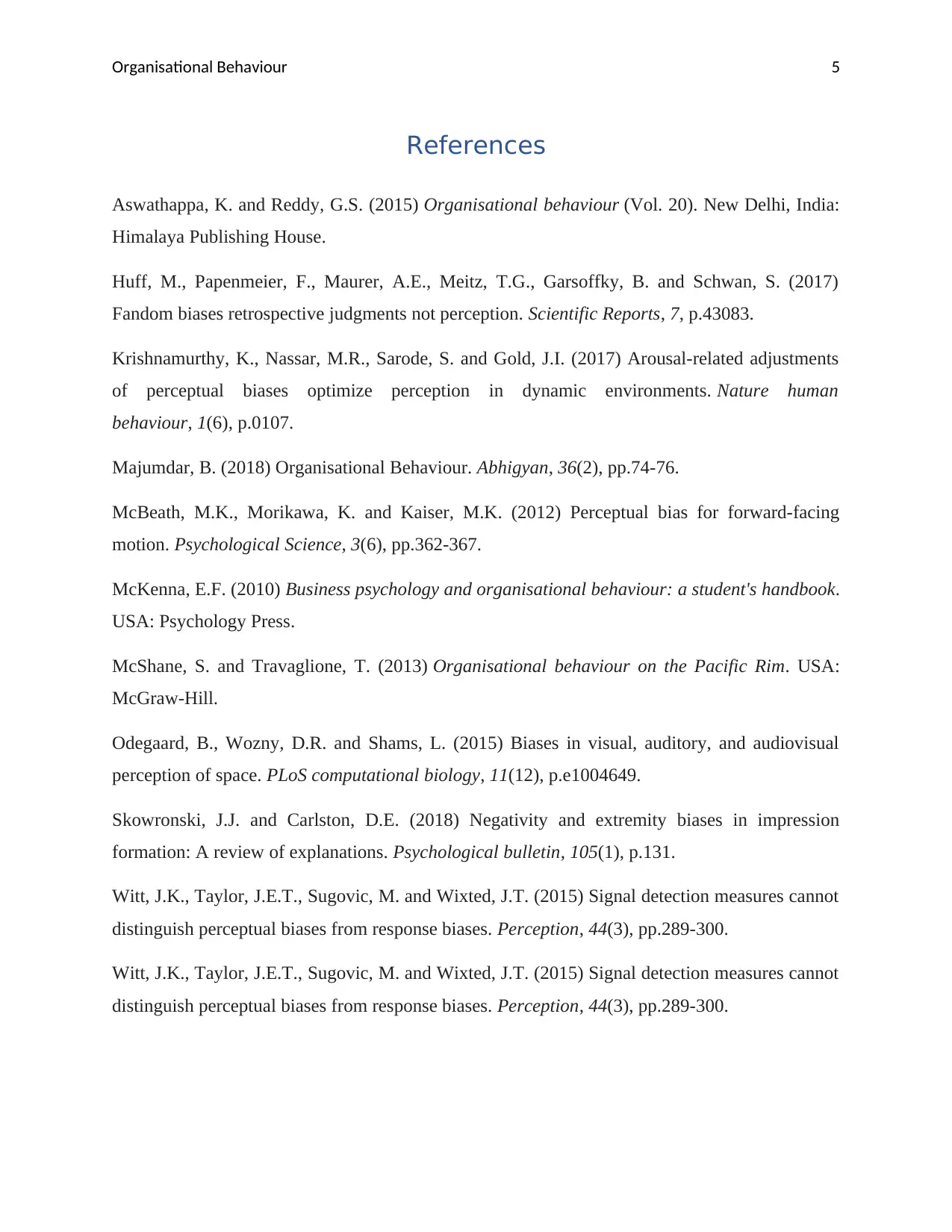
Organisational Behaviour 5
References
Aswathappa, K. and Reddy, G.S. (2015) Organisational behaviour (Vol. 20). New Delhi, India:
Himalaya Publishing House.
Huff, M., Papenmeier, F., Maurer, A.E., Meitz, T.G., Garsoffky, B. and Schwan, S. (2017)
Fandom biases retrospective judgments not perception. Scientific Reports, 7, p.43083.
Krishnamurthy, K., Nassar, M.R., Sarode, S. and Gold, J.I. (2017) Arousal-related adjustments
of perceptual biases optimize perception in dynamic environments. Nature human
behaviour, 1(6), p.0107.
Majumdar, B. (2018) Organisational Behaviour. Abhigyan, 36(2), pp.74-76.
McBeath, M.K., Morikawa, K. and Kaiser, M.K. (2012) Perceptual bias for forward-facing
motion. Psychological Science, 3(6), pp.362-367.
McKenna, E.F. (2010) Business psychology and organisational behaviour: a student's handbook.
USA: Psychology Press.
McShane, S. and Travaglione, T. (2013) Organisational behaviour on the Pacific Rim. USA:
McGraw-Hill.
Odegaard, B., Wozny, D.R. and Shams, L. (2015) Biases in visual, auditory, and audiovisual
perception of space. PLoS computational biology, 11(12), p.e1004649.
Skowronski, J.J. and Carlston, D.E. (2018) Negativity and extremity biases in impression
formation: A review of explanations. Psychological bulletin, 105(1), p.131.
Witt, J.K., Taylor, J.E.T., Sugovic, M. and Wixted, J.T. (2015) Signal detection measures cannot
distinguish perceptual biases from response biases. Perception, 44(3), pp.289-300.
Witt, J.K., Taylor, J.E.T., Sugovic, M. and Wixted, J.T. (2015) Signal detection measures cannot
distinguish perceptual biases from response biases. Perception, 44(3), pp.289-300.
References
Aswathappa, K. and Reddy, G.S. (2015) Organisational behaviour (Vol. 20). New Delhi, India:
Himalaya Publishing House.
Huff, M., Papenmeier, F., Maurer, A.E., Meitz, T.G., Garsoffky, B. and Schwan, S. (2017)
Fandom biases retrospective judgments not perception. Scientific Reports, 7, p.43083.
Krishnamurthy, K., Nassar, M.R., Sarode, S. and Gold, J.I. (2017) Arousal-related adjustments
of perceptual biases optimize perception in dynamic environments. Nature human
behaviour, 1(6), p.0107.
Majumdar, B. (2018) Organisational Behaviour. Abhigyan, 36(2), pp.74-76.
McBeath, M.K., Morikawa, K. and Kaiser, M.K. (2012) Perceptual bias for forward-facing
motion. Psychological Science, 3(6), pp.362-367.
McKenna, E.F. (2010) Business psychology and organisational behaviour: a student's handbook.
USA: Psychology Press.
McShane, S. and Travaglione, T. (2013) Organisational behaviour on the Pacific Rim. USA:
McGraw-Hill.
Odegaard, B., Wozny, D.R. and Shams, L. (2015) Biases in visual, auditory, and audiovisual
perception of space. PLoS computational biology, 11(12), p.e1004649.
Skowronski, J.J. and Carlston, D.E. (2018) Negativity and extremity biases in impression
formation: A review of explanations. Psychological bulletin, 105(1), p.131.
Witt, J.K., Taylor, J.E.T., Sugovic, M. and Wixted, J.T. (2015) Signal detection measures cannot
distinguish perceptual biases from response biases. Perception, 44(3), pp.289-300.
Witt, J.K., Taylor, J.E.T., Sugovic, M. and Wixted, J.T. (2015) Signal detection measures cannot
distinguish perceptual biases from response biases. Perception, 44(3), pp.289-300.
⊘ This is a preview!⊘
Do you want full access?
Subscribe today to unlock all pages.

Trusted by 1+ million students worldwide
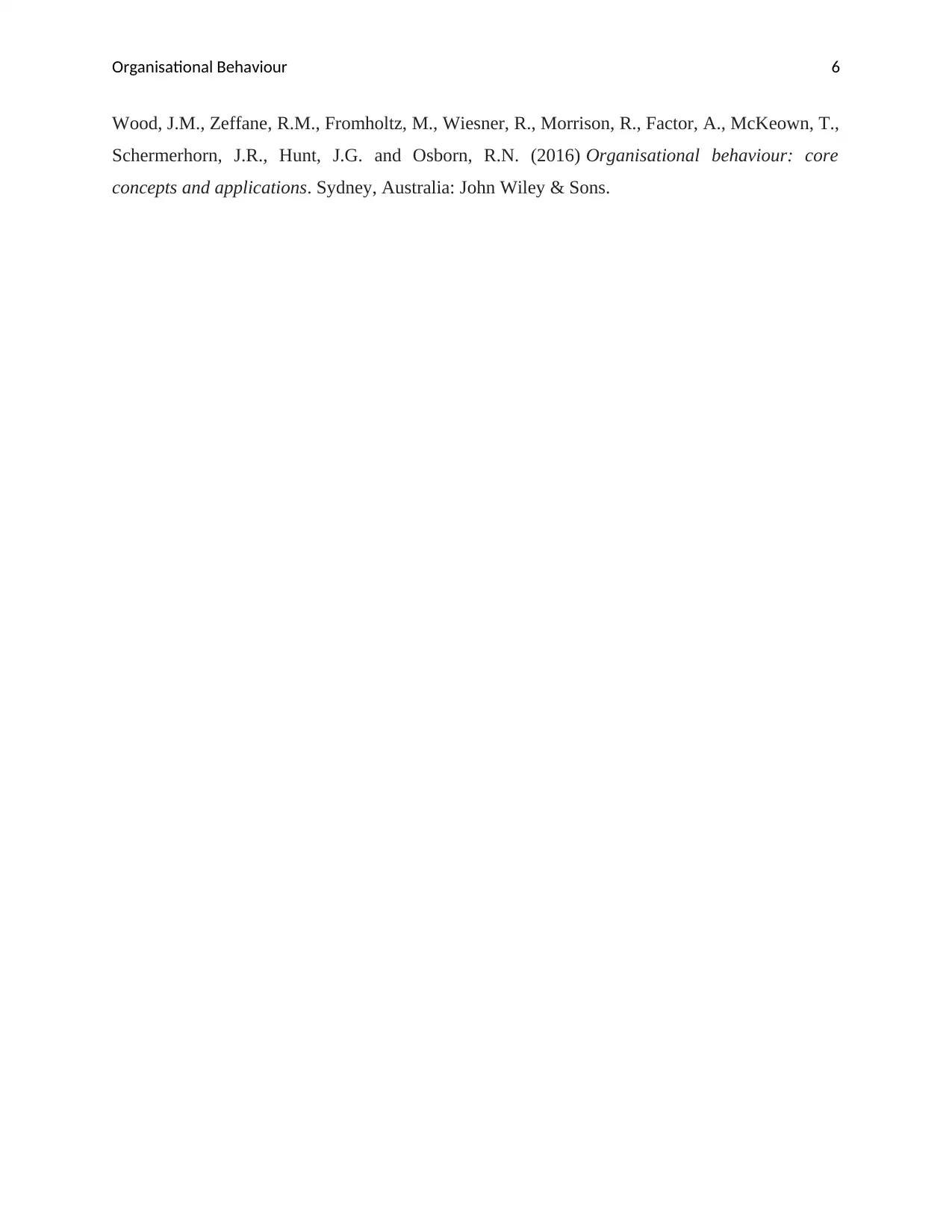
Organisational Behaviour 6
Wood, J.M., Zeffane, R.M., Fromholtz, M., Wiesner, R., Morrison, R., Factor, A., McKeown, T.,
Schermerhorn, J.R., Hunt, J.G. and Osborn, R.N. (2016) Organisational behaviour: core
concepts and applications. Sydney, Australia: John Wiley & Sons.
Wood, J.M., Zeffane, R.M., Fromholtz, M., Wiesner, R., Morrison, R., Factor, A., McKeown, T.,
Schermerhorn, J.R., Hunt, J.G. and Osborn, R.N. (2016) Organisational behaviour: core
concepts and applications. Sydney, Australia: John Wiley & Sons.
1 out of 7
Related Documents
Your All-in-One AI-Powered Toolkit for Academic Success.
+13062052269
info@desklib.com
Available 24*7 on WhatsApp / Email
![[object Object]](/_next/static/media/star-bottom.7253800d.svg)
Unlock your academic potential
Copyright © 2020–2025 A2Z Services. All Rights Reserved. Developed and managed by ZUCOL.





